#ephesus map
Explore tagged Tumblr posts
Note
Do you have like a full map of where all of the top Ancient Greek locations were? And if so can I see pls pls pls 🙏
DO I :D
I have the locations of Ancient Greek cities (even had to hunt down the location of the non-existent/do they exist? ones)! I have the Odyssey Journey mapped out! I am currently mapping out the Aeneid!
SEE THIS IS WHAT ADHD DOES TO YOU!

I can give you an upclose!
The coast of Anatolia! With islands! (modern-day Turkey!)

1 - Troy
2 - Tenedos
3 - Lesbos
4 - Didyma
5 - Claros
6 - Miletus
7 - Ephesus
10 - Delos
23 - Chois
27 - Seriphos
The Peloponnese! With more islands!

11 - Sparta
12 - Cythera
13 - Crete
14 - Athens
16 - Argos
17 - Mycenae
18 - Corinth
19 - Epidarus
21 - Pylos
Upper Greece! No islands!

9 - Delphi
12 - Ithaca
15 - Thebes
20 - Epirus
30 - Scheria
31 - Pherae
And Colchis (8)!

And see my red lines? That's the Odyssey Journey! :D

The Aeneid (Bright Red) is a wip rn :3
THIS IS WHAT HYPERFIXATIONS DO TO YOU AHHHHHH
21 notes
·
View notes
Text
Chapter 1 of Schizophrenia, Third Edition: Concept of schizophrenia - past, present, and future
Basically, try as psychologists might to define schizophrenia, even in the present its defintion stays ever-changing. Still, we need a working definition to provide a foundation for the study of the disease, so this will overview the history of concepts of psychosis and schizophrenia.
Although the name "schizophrenia" is relatively new, only being coined in the last century, the concept of psychosis is very old. Based on portrayals in early history and literature, we know that schizophrenia-like psychoses have been recognized since at least the first millenium BC. One of the earliest descriptions of a psychotic condition is in the book of Samuel in the Old Testament. After David successfully defends the Israelites against the Philistines by killing Goliath and then wins several subsequent battles, King Saul becomes increasingly paranoid about David's military prowess, planning and attempting to murder David. Saul even begins to have hallucinatory-like experiences.
Moving on to the classical era in Greece and Rome, there are plenty of descriptions regarding paranoid schizophrenia-like psychotic states. Greek tragedy has an abundance of portrayals of individuals tormented by psychosis, driven to committing horrendous acts. In "The Bacchae", Agave murders her son Pentheus, driven by the delusional belief that he is a lion. In "Medea", after Jason abandons his wife Medea, she falls into a psychotic rage that drives her to murder their two children. In "The Oresteia", Orestes is pursued by Furies until he finally loses reason and lapses into madness. And there are many more examples!
In the 16th and 17th centuries, Elizabethan and Jacobean drama are also filled with portrayals of individuals who experience schizophrenia-like psychotic states. Some of the best known are in the plays of Shakespeare - Hamlet, Lear, Othello, and Lady Macbeth all experience psychosis.
Not only were there literary portrayals documenting that schizophrenia-like illnesses have been present for at least three millennia, but the "medical" literature of these early times shows evidence that psychotic disorders similar to schizophrenia were recognized as important medical illnesses. They are described in the writings of Hippocrates, Galen, or Soranus or Ephesus. While the disorders described by these forefathers don't perfectly map onto modern classification systems, there are striking similarities. Mental illnesses were clearly seen as physical in origin. There were five groups of illness: melancholia, phrenitis, mania, hysteria, and epilepsy. Mania was essentially equivalent to our concept of psychosis. However, psychotic disorders were not further subdivided until the late 19th century.
Emil Kraepelin (1919) gave us the framework that created the modern concept of schizophrenia. One of his many great contributions was to take the general concept of psychosis and subdivide it into two major groups based on his observations of differences in course and outcome. One group of patients had an episodic course typically presenting with full remission of symptoms. A second group had a chronic course and typically progressed into a deteriorated state. He named the two groups "manic-depression" and "dementia praecox."
Kraepelin did not consider psychotic symptoms to be the most important features of dementia praecox. When he talked about the symptoms, what he considered most important would be what we call today the negative symptoms. There are passages in Kraepelin's textbook that indicate he thought negative symptoms were the most important symptoms of schizophrenia.
Bleuler (1950) on the other hand, tried to clarify the group of schizophrenias by very explicitly attempting to identify what he considered to be the underlying fundamental abnormality. As a consequence he divided the symptoms of schizophrenia into two categories: fundamental and accessory symptoms. Bleuler believed that fundamental symptoms were present in all patients, and tended to occur only in schizophrenia. The accessory symptoms on the other hand could occur in a variety of disorders. Depending on how we interpret his writings, we can argue that Bleuler identified four to six fundamental symptoms of schizophrenia. These included: the loss of continuity of associations, loss of affective responsiveness, loss of attention, loss of volition, ambivalence, and autism. These symptoms correspond somewhat closely to the current negative symptoms. In Bleuler's thinking, these symptoms reflecting abnormalities in basic cognitive and emotional processes provided the basis for other types of symptoms observed in the illness. Accessory symptoms included those such as delusions and auditory hallucinations.
When Kraepelin named the disorder "dementia praecox", he intended to highlight the fact that it had an early (praecox) onset and differed from another type of dementia described by his colleague Alois Alzheimer. However, in choosing the term "dementia", he wished to highlight the fact that the illness was chronic and deteriorating. Bleuler chose to rename the disorder to highlight his own view that a fragmenting of thinking (thought disorder) was the most important feature (as well as to eliminate the concept that deterioration was inevitable.) Bleuler's name eventually prevailed over Kraepelin's. Unfortunately, the meaning of schizophrenia, being "split mind", has many assume that schizophrenia means split personalities, but to this day no alternative has been coined.
Throughout most of the 20th century, Bleuler's perspective dominated, and clinicians all over the world were taught to define and diagnose schizophrenia based on the symptoms that Bleuler saw as fundamental.
The emphasis on negative symptoms shifted in the 1960s and 1970s. This change came primarily from an interet of improving diagnostic precision and reliability. Since delusions and hallucinations are essentially "all or nothing" phenomena, that are easy to recognize and define, they were steadily given greater prominence, being placed at the forefront of the definition of schizophrenia. This emphasis arose because of the influence of Kurt Schneider.
Schneider, like Bleuler, wanted to identify symptoms that were fundamental. This led him to discuss "first-rank" symptoms, that were characterized by loss of autonomy, such as thought insertion or delusions of being controlled by outside forces. Schneider's ideas were incorperated into many diagnostic tools. When diagnostic criteria like the RDC and DSM-III were written, they essentially ignored negative symptoms.
As the present moves towards the future, corrective adjustments are already beginning to occur. These often occur by returning to the past and coming full circle to the work of Kraepelin, Bleuler, Jackson, and Schneider, paradoxically! Clinically, the emphasis on negative symptoms as well as psychotic symptoms is leading to increased interest in the full range of symptoms of schizophrenia, and for methods for treating that full range. Complemented by the return to negative symptoms is the return to cognitive symptoms as well. Many negative symptoms are cognitive in nature, such as alogia and avolition and attentional impairment. Increasingly, investigators are returning to the original insights of Kraepelin and Bleuler that the core symptoms of schizophrenia represent a fundamental deficit in cognition and emotion.
#nerdpost#graypost#psychology#psychosis#schizophrenia#history#long post#new psychosis book new posts from me#book: schizophrenia third edition
2 notes
·
View notes
Photo

The text is in Latin : (panel on the left) 'Democritus Abderites deridebat, Heraclites Ephesius deflebat, Epichthonnis Cosmopolites deformabat' / 'Democritus of Abdera laughed at it' [the world], 'Heraclitus of Ephesus wept over it', 'Epichtonius Cosmopolites portrayed it'; (above the cap) 'Nosce te ipsum' / 'Know thyself' (from the Greek dictum 'gnothi seauton' reputedly inscribed on the temple of Apollo at Delphi);
Across the cap’s brow: 'O caput ellebore dignum' / 'O head, worthy of a dose of hellebore' (a poisonous plant).
On the cap's ears: 'Auriculas asini quis non habet' /'Who does not have donkey's ears?', a phrase ascribed to Lucius Annaeus Cornutus, a Roman stoic philosopher from the 1st century AD.
The Latin quote immediately above the map is from Pliny the Elder's 'Natural History' (bk. 2 ch. 72) 'Hic est mundi punctus et materia gloriae nostrae, hic sedes, hic honores gerimus, hic exercemus imperia, hic opes cupimus, hic tumultuatur humanum genus, hic instauramus bella, etiam civica.' / 'For in the whole universe the Earth is nothing else and this is the substance of our glory, this is its habitation, here it is that we fill positions of power and covet wealth, and throw mankind into an uproar, and launch wars, even civil ones.'
Below the map is the reason for this, taken from Ecclesiastes, 1.15: Stultorum infinitus est et numerus' / 'The number of fools is infinite' (7).
Another quote from Ecclesiastes (1.2) is shown as engraved in the cup at the top of the jester's staff on the right: 'Vanitas vanitatum et omnia vanitas' / 'Vanity of vanities, all is vanity'.
The badges on the decorative belt crossing the figure's shoulder on the left read: 'O curas hominum, O quantum est in rebus inane' / 'Oh, the worries of the world; oh, how much triviality is there in the world', which is the opening of the 'Satires' of Aulus Persius Flaccus’ Satires; 'Stultus factus est omnis homo' / 'All men are without sense' (Jer. 10.14) and 'Universa vanitas omnis homo' / 'All things are vanity, by every man living' (Psalm 39.6).
There is an allusive reference to this map in Robert Burton's Anatomy of Melancholy (1621).
Fool's World Map: 'Stultorum infinitus est numerus'. Recto. G201:1/43
6 notes
·
View notes
Text
Discover Turkey's Architectural Treasures: An Unforgettable Journey
Turkey’s diverse architecture is a tapestry woven from centuries of cultural and historical influences. For architecture enthusiasts, a guided tour of Turkey offers a chance to dive deep into structures that tell the story of ancient civilizations, empires, and modern innovations.
Istanbul: Byzantine to Ottoman Splendor
Starting in Istanbul, visitors encounter iconic landmarks like the Hagia Sophia, a blend of Byzantine and Islamic influences. Nearby, the Blue Mosque stands as an Ottoman masterpiece with its domed skyline and delicate minarets. Each structure in Istanbul echoes the city’s layered history, from Roman relics to contemporary Turkish designs.
Cappadocia’s Cave Dwellings: Ancient Innovation
Heading east, Cappadocia captivates with its cave dwellings and churches carved directly into volcanic rock. Known for its surreal landscapes, this region highlights the resourceful architecture of early Christian communities, who created homes, monasteries, and even underground cities for protection and worship.
Ephesus and Beyond: Roman Ruins and Timeless Grandeur
In Ephesus, visitors can walk the same paths once tread by Romans in the ancient world. The city’s well-preserved ruins, including the Library of Celsus and the Temple of Artemis, showcase Roman engineering marvels and intricate designs that remain breathtaking centuries later.
Bridging History and Modernity
Turkey’s architecture is an evolving story, combining historic preservation with modern Turkish innovations. New developments in cities like Ankara showcase contemporary Turkish architects who bridge tradition and modernity with creativity and respect for their heritage.
Why Choose a Guided Tour?
With expert guides, you’ll gain insight into the history, symbolism, and cultural significance of each structure, making every building an experience rather than a stop on the map. Whether you’re an architecture student, a professional, or simply passionate about history and design, a Turkey architecture tour offers a profound exploration of the country’s rich heritage.
#Turkey architecture tour#architecture tours#educational travel company#Architecture Tours in Turkey
0 notes
Text
FRESH MANNA
OPEN DOOR
Isaiah 45:1-2
Open doors signify communication and agreement, implying that the communication path between parties is smooth and flowing.
There are doors in every sphere of life, when these doors open, it means things are good and beneficial to all but when it closes, problems arise, and our text says to open before him that shall not be shut.
Some doors lead into places that are not right for us, even though we may not initially realize it as Proverbs 14:12 puts it, an open door, a mapped-out route, or a road may not always be what it seems.
Some open doors may look like a blessing at first glance, but God knows what is on the other side, that’s why we must depend on the Lord to lead and guide us to and through divinely opened doors as stated in Revelation 3:8.
Circumstances may force us to knock on, open and go through doors that shouldn’t have been open and sometimes, the consequences of these open doors may have a far-reaching effect than we care to admit or are willing to deny.
The burden of an unauthorised open door could cut us off from seeing a divine open door or stop us from going through it because we become occupied with the wrong door.
There are many adversities as Paul puts it in 1 Corinthians 16:9 that stand against our open door to test our faith and strengthen our hope.
Even in the world, we are expected to strive to go through open doors, ones which may not be good for us, however, when and if God opens these doors, the enemy will fight to keep us out.
When the Lord opens a divine door for us, He closes the wrong ones to help us, as seen in Acts 16:6-7- they proceeded farther west into Phrygia. Had they continued in the direction they wanted, they would have travelled through Asia but the Spirit prevented this stopping them from witnessing in Bithynia.
Unfortunately, so many don’t heed the Spirit’s warning, they head on and force open a wrong closed door or choose to go through a wrong open door.
God will open the right doors and close the wrong doors for us and when He opens a door, He helps us to recognize the open doors- the door of blessings, opportunities, mercy, and grace, and help us to confidently go through without fear.
Do we ever wonder if the door opened before us was opened by God? Or by Satan or neither?
God will never open a door to an opportunity that does not line up with His Word, so, always check the scripture to confirm His Word.
We pray fervently for an open door as seen in Colossians 4:3, but when those doors become open; doors of business, family, children, financial increase and health, they sadly become our tools of avoiding the service of God, we may begin to use these open doors as an excuse for not wholeheartedly serving the Lord.
If you have been praying for an open door, and if the open door causes you discomfort, it may be a sign that God is opening a door to release you from something.
Just like Apostle Paul who used it four times as a metaphor to describe something more abstract.
First, as an opportunity to reach the lost as seen in Acts 14:27.
Paul described his work in Ephesus as a great and effective door opened for him.
While he was incarcerated in Rome, he requested prayers that “God would open to [him] a door for the word” in Colossians 4:3.
What would your open door look like? Are you feeling a nudging to serve specifically? Do you keep seeing a specific need? What doors is God opening for you so that you can serve Him? John 10:9 calls Jesus the door, the open door for you to walk on your high places victoriously. Go for it!
PRAYER: Lord, I thank you for the open doors before me, help me to always choose the right and wise doors in Jesus’ name. Amen.
Shalom
Women of light international prayer ministries.
0 notes
Text
Seven Keys to Spiritual Devotion: Lessons From Ephesus

To the Church in Ephesus
💜 “To the angel of the church in Ephesus write:
These are the words of him who holds the seven stars in his right hand and walks among the seven golden lampstands.
I know your deeds, your hard work and your perseverance. I know that you cannot tolerate wicked people, that you have tested those who claim to be apostles but are not, and have found them false.
You have persevered and have endured hardships for my name, and have not grown weary.
Yet I hold this against you: You have forsaken the love you had at first.
Consider how far you have fallen! Repent and do the things you did at first. If you do not repent, I will come to you and remove your lampstand from its place.
But you have this in your favor: You hate the practices of the Nicolaitans, which I also hate.
Whoever has ears, let them hear what the Spirit says to the churches. To the one who is victorious, I will give the right to eat from the tree of life, which is in the paradise of God.
~Revelation 2:1-7 ✝️
Devotional
Recently, we have been exploring how we can practically grow in faith. Through contemplating Scripture, we have discovered resilient faith develops and deepens through relational connection with God. As we know Christ, we trust Him.
This week, we are in the book of Revelation. This prophetic text gives us an unveiled look into the spiritual realm. Across the next seven days, we will be reflecting on Jesus' messages to seven ancient churches and unpacking how they apply to us. Each day will reveal one thing you can do to strengthen your spiritual devotion. Can you collect them all?
Today's passage spotlights the church in Ephesus.
Consider your favorite "maps" app. Are you thankful for it? Modern sat-navs utilize live traffic data to help you discover the ideal route. As you are driving, roads ahead turn red as congestion approaches. It's a warning system. Have you ever pondered, though, why your sat-nav does that for you? Is it to mock you about the delays ahead? Or to make you feel guilty about your journey? Of course not. The sat-nav warns you so you can adjust your route and avoid the pain. That's what warnings are for.
When Jesus gives us warnings, we must treat them in a similar way. Some of the content of Revelation is difficult. However, it is not there to cause despair. It is there to trigger changes of direction. When Jesus addresses the Ephesians, he shares a praise and a challenge. On the plus side, they were solid, hard-working gospel people who never compromised on the truth: an example for us all. Jesus praises their faithful endurance.
However, Jesus also has a stern caution. Despite their works, the Ephesian Christians had fundamentally forgotten their core identity. They had abandoned love. The church had lost zeal for Jesus and consequently wasn't operating with the life-giving love God's people should be defined by. They were going through the motions. Have you ever felt like that?
Like the sat-nav, Jesus warns the church to cause them to change route. He wanted the best for them. He wanted them eating "from the tree of life" (Verse 7), not tasteless religion. It wasn't too late! Equally, it's not too late for us today.
Nothing we do "for" Jesus makes sense without love. God is love. When love vanishes, everything else is vanity. Our spiritual life becomes arid. Even supposedly "impressive" works achieve little where love is absent. We become like "a clanging cymbal" (1 Corinthians 13:1). God is interested in our hearts, not our achievements.
Love has to be our centerpoint.
How, though, do we get our spark back? Jesus tells us. Return to your first love. Simply be with Christ. Right now. Find the reset button. This is our first key to spiritual devotion. Go back to the basics. Remember when you first met God. Remember His blessings. Remember His miracles. As you fall back in love with Jesus, everything else follows. 💜🙏🙂
Source: Glorify App
Image: agodman.com
My Glorify Referral Link: https://share.glorify-app.com/MRSPINO777 ✝️
#jesusfreak#bibletruth#godislove#jesusisthelightoftheworld#jesusneverfails#godisgood#bible reflection#follow jesus#biblescripture#bibleverse#christian motivation#christian inspiration#christian faith#jesustakethewheel#jesuschrist#jesussaves#jesusisthewaythetruthandthelife#jesusisking#bible reading#biblestudy#bible study#bibledaily#god is our rock#our daily bread#faithoverfear#god is faithful#faith in jesus
1 note
·
View note
Text
Rick Steves Istanbul: With Ephesus Cappadocia - Lale Surmen Aran
EPUB & PDF Ebook Rick Steves Istanbul: With Ephesus Cappadocia | EBOOK ONLINE DOWNLOAD
by Lale Surmen Aran.

Download Link : DOWNLOAD Rick Steves Istanbul: With Ephesus Cappadocia
Read More : READ Rick Steves Istanbul: With Ephesus Cappadocia
Ebook PDF Rick Steves Istanbul: With Ephesus Cappadocia | EBOOK ONLINE DOWNLOAD Hello Book lovers, If you want to download free Ebook, you are in the right place to download Ebook. Ebook Rick Steves Istanbul: With Ephesus Cappadocia EBOOK ONLINE DOWNLOAD in English is available for free here, Click on the download LINK below to download Ebook Rick Steves Istanbul: With Ephesus Cappadocia 2020 PDF Download in English by Lale Surmen Aran (Author).
Description Book:
Walk in the footsteps of emperors and sultans, marvel at some of the greatest monuments on earth, and experience the wonders of East and West with Rick Steves! Inside Rick Steves Istanbul you'll find:Comprehensive coverage for spending a week or more exploring IstanbulTop sights and hidden gems, from the world's largest domed churches and monumental mosques to relaxing Turkish bathsHow to connect with local culture: Haggle with merchants in the lively Grand Bazaar, shop along sophisticated avenues, and watch whirling dervishes in actionBeat the crowds, skip the lines, and avoid tourist traps The best places to eat, sleep, and relax Self-guided walking tours of lively neighborhoods and incredible museumsDetailed neighborhood maps for exploring on the goStrategic advice from trusted Rick Steves Europe tour guides Lale and Tankut Aran on how to get the most out of your time and money, with rankings of their must-see favoritesUseful resources including a packing list, a Turkish phrase
0 notes
Link

Come, Visit & Discover #Ephesus #EphesusTour #CelsusLibrary #Archaeology #History - www.ephesus.co
1 note
·
View note
Text
RHAPSODY OF REALITIES DAILY DEVOTIONAL
Saturday, 12th November 2022
TRAVAILING IN PRAYER FOR THE NATIONS
Ask of me, and I shall give thee the heathen for thine inheritance, and the uttermost parts of the earth for thy possession (Psalm 2:8).
PASTOR CHRIS OYAKHILOME PHD
The Message translation of our theme verse says, “What do you want? Name it: Nations as a present? continents as a prize?” I first came across this verse when I was 15 years of age, and I prayed to the Lord according to this scripture. In response, the Spirit of the Lord said to me, “I’ve given you the nations!”
At that tender age, I was concerned about the abysmal state of the unbelievers in the nations of the world; they’re in spiritual darkness and alienated from the life of God. They’re hopeless and without God in the world. So, I got the world map (atlas), and many times, I’d place my hands on it, speaking and prophesying over the nations of the world and over men’s lives.
I travailed in prayer for the needy people of the world. I’d pray and cry, broken before the Lord. Oh, how I wept in prayer for the nations of the world! Ever since, I knew that not one nation could shut its doors against me. Today, the Lord is doing many great things through us in the nations of the world.
When He says, “Ask of me, and I shall give thee the heathen for thine inheritance…,” He’s talking about the souls of men, impacting them with the Gospel and the righteousness of God. That’s what the apostles did, and it’s what we must do today, and nothing can stop us.
When Paul preached the Word in Ephesus, there was a lot of resistance of course, but it wasn’t enough to stop the work of the Gospel. The Bible says, “So mightily grew the word of God and prevailed” (Acts 19:20). The key to this kind of result is travailing in prayer. Travail in prayer for your nation, city, town, school, place of work, etc., and surely, the Word of God will grow mightily therein, and prevail. Hallelujah!
PRAYER
Dear Father, your love compels me to intercede in heartfelt prayers and to preach the Gospel to the lost, bringing them out of darkness into your marvellous light. The Word prevails in my city and my nation, and around the world, and the Name of the Lord is glorified. Amen.
FURTHER STUDY:
1 Timothy 2:1-2 I exhort therefore, that, first of all, supplications, prayers, intercessions, and giving of thanks, be made for all men; 2 For kings, and for all that are in authority; that we may lead a quiet and peaceable life in all godliness and honesty.
Jeremiah 29:7 And seek the peace of the city whither I have caused you to be carried away captives and pray unto the Lord for it: for in the peace thereof shall ye have peace.
Ezekiel 3:17 Son of man, I have made thee a watchman unto the house of Israel: therefore hear the word at my mouth and give them warning from me.
3 notes
·
View notes
Note
Dear classicalmonuments, why are there so many Greek constructions in Turkey?

The western shore of modern day Turkey borders the Aegean sea, and in a borderless map it seems only natural for the greek tribes to have arrived, mixed with and influenced the native Anatolian population on the easternmost shore of the Sea.
A lot of native religion way mixed with the Greek one, evident mostly in Ephesus with it's own version of a Greco- Anatolian hybrid goddess, and even in the currently discussed Termessos with their own Zeus - Solymeus.
Later Roman, Byzantine and Muslim influences changed and shaped the land to be the country you know it to be now, vastly different from it's classic roots.
Hope my answer helped 😁
40 notes
·
View notes
Photo

NIGHT 12 UNIVERSE MAP
ILLYRIAN PLANETS
Illyria - A military base turned epicenter of rebellion. Illyria is the alliance of planets formed to advocate for democracy and freedom. But their idealistic values have been washed away by the strain of the twelve years fighting back against Verona. Illyria is known for it's home planet with distinct purple soil. Population is about nine thousand.
Ephesus - Main Illyrian civilian planet. It features mostly plains biomes and has seven main cities with scattered farming town surrounding them. The population is int he low millions. For the most part it is considered a democratic utopia, despite the fact that it is isolated and technologically behind the times. It is said to be the only place the war hasn’t touched.
Athe - Inhospitable desert planet. Too hot for any life to survive. Rovers have been sent to explore but the planet was deemed to hot to support life and thus no terraforming was attempted.
Navarre - Inhospitable lava planet. No rovers have ever touched down.
VERONIAN PLANETS
Verona - The first successfully terraformed planet, expanded into an alliance of planets. Led by a singular military dictator, Verona is the strongest force in the solar system. the Veronians value tradition and hierarchy. They are currently winning the war, but their forces are being exhausted trying to quell growing uprising in neutral planets. The planets is home to many biomes and ecosystems. The population is in the low billions.
Tyre - Main Veronian civilian planet. It is essentially a copy of Verona, but smaller. The cities are much closer to one another and there is significantly less farmland and natural reserve. The population is approximately two billion. this planet is home to the lower and middle class citizens of the Veronian alliance. While Verona is reserved for the upper class, serving class, and farmworkers.
Scol - A debt planet now privately funded by the Veronian army where they store war criminals and prisoners. They also use these prisoners as free laborers to build war ammunition and ships.
Ero - Technically a moon of Tyre, but terraformed to be a paradise planet with a Safari theme.
Padua - A defunct tropical island resort paradise planet next to a black hole. It is technically under Veronian control but it was abandoned.
NEUTRAL PLANETS
Messina - City planet. A mecca of dirty high rise buildings practically folding in on each other. The smog layer covered the planet so completely that it takes a skilled pilot to land or leave the planet’s atmosphere. For that reason it is the populated planet that get the least amount of external interference. but it still have Veronian influences. Has a highly volatile militia monitoring the population.
Elsinore - Terraformed civilian planet. It’s entire surface is covered in ocean. Some of it is shallow, and when the tide turns it turns to a muddy flatland that is not possible to cross on foot without special boots. The cities float and follow the tides. Elsinore is a major export of fish and salt.
Vien - A basic debt planet. Although it looms over Elsinore it houses prisoners from all the neutral planets, especially Messina. While it is not officially owned by Verona, Veronian officials have made deals with the wardens to house war prisoners.
Enice - A former prison planet turned into a war zone. It has two moons that are also war zones.
tag list (dm to be added/removed): @siennasophia-b @alecsaltylightwood @valaers @novel-novelist @rhikasa @talesofthedivine @rcvolutions @givenchywrites
50 notes
·
View notes
Photo




Equally near and equally far
mural intervention with paint and clay casts, Cultuurcentrum Strombeek, 2019
Equally near and equally far is fusion of 2 seemingly incompatible metalanguages: mythology and mathematics.
The mural refers to a “corporeal trophy” of the Goddess of Ephesus, also known as Artemis or Diana in the Roman times. She was depicted as covered entirely with breasts, denoting fertility, nourishing the living. (This interpretation began in late antiquity and resulted in designations of the Ephesian goddess as Diana Efesia Multimammia.) The mural is in fact an iterated skin map into two dimensions, as a Voronoi diagram.
The Voronoi diagram is a simple mathematical tool for quantitative characterization of the orderliness of points distributed on a surface. It frames chaos with order. It is based on the minimal distance needed to reach a landmark (for example if you need to go to a grocery store, the most natural algorithm is going to the nearest one). So this diagram is a computational concept that represents partition of the given space onto regions, with bounds determined by distances to a specified family of objects/points. The application area of this concept varies from archaeology, anthropology and astrology to biology, epidemiology, geology, geography, robotics and many more…
Today, mathematics and computing have become one of the many contemporary gods. Mathematics has a divine status and we rely on it almost completely. The belief is that everything is potentially computable and predictable. The long forgotten cult of Diana was replaced by the cult of data, the commodification of human capacity for thought and the dismissal of critical reason in favour of programming. Life itself is increasingly construed via statistics, metadata, modelling, mathematics.
But knowledge cannot be reduced to computational information processing. We have to recover the ability to think, to intuit, to fantasize. Life itself is an open system, nonlinear and exponentially chaotic. Overlapping a myth with a abstract algorithm is posing the question: can myth corrupt mathematics?
In his Mythologies, Roland Barthes argues that mathematical language cannot be distorted, because “it has taken all possible precautions against interpretation”, but also that “myth can reach everything, corrupt everything”. He writes: “…mathematical language is a finished language, which derives its very perfection from this acceptance of death. Myth, on the contrary, is a language which does not want to die: it wrests from the meanings which give it its sustenance an insidious, degraded survival, it provokes in them an artificial reprieve in which it settles comfortably, it turns them into speaking corpses”…
Equally near and equally brings forth this seemingly incompatible combination of two distinct languages. I attempted to alter the quintessential language of reason and blur the threshold between the calculable and the incalculable. I try to turn this instrument of calculation into an instrument of liberation, to open up the possibility of a holistic aesthetics, and a different politics. Right brain pattern recognition combines with left brain linear/mathematical sequence move perception toward equilibrium between the two hemispheres, between masculine and feminine, between abstract and iconic.
7 notes
·
View notes
Photo


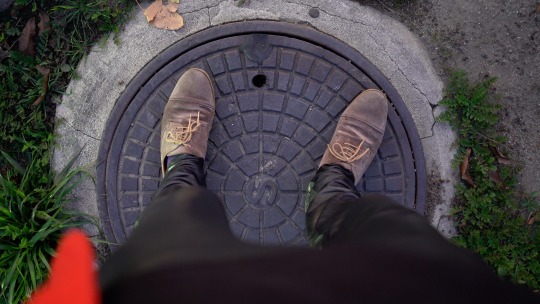
Boom, bang, bash... iyi, kötü ve cici: The Laser Kid... Giving birth to a version of myself while the world is entrenched in something so dodgy and I don’t mean the virus. There is something else that bothers me since the last massive full moon, largest ever seen, it sent chills down me spine. Ominous I said, nobody agreed. Clearly, these ‘benign’ governments all over the shop are manipulating the people for something extreme 5 inches away. Daylight clear. We got an asymptomatic disease (holy grail of biowarfare, Corona is still the Anthrax, kids, under an updated firmware, FYI). The trouble maker Northern Hemisphere is locked down, lives and finances are ‘paused’, right of movement is almost globally stripped. Next, the internet will go out and the terrestrial fucking ‘alien’ might declare itself the messiah. Yallah, chauffeur, Yallah. — Ancient Theories of the Future is here. Shock of the New.
🏗🖐🏻 From the macro base of the civilisation: ÇATALHÖYÜK, to the micro tip of what it became: NVC... and the child who reads the archaeology of the psyche like a book, since 1986 connects the dots, strips the temporal disguise of the underlying (dis)order on the MAP OF THE UNIVERSE (the 3rd Dimension of the complex medium that is 9, my spirit at work... thank you for coming).
💣🦠🕳📯����🇷 #CentralRegion #GroundZero #NeolithicRevolution #AgriculturalRevolution settlements citystates Empires #CradleofCivilisation #Homeland of all #Myths #Cybele #Bull #Anatolia #Judaism #Christianity #Islam #Buddhism #Paganism #Gobeklitepe #Catalhoyuk #Ephesus #nicaea #Troy #Tarsus #cappadoccia #Antioch #Urfa #Tigris Euphrates #TaurusMountains #Mesopotamia Sumer assyria Akkadian Hittite Hellen Persia Spqr #TheLaserKid #Handmade #1980s #teacher
#Laser Kid#Ancient theories of the future#Corpus Enigma#New Vague City#Lost Angles#Sci-if#OpusKiNo#Gobeklitepe#Myths#Nicaea#A#The Bull
1 note
·
View note
Text
The Louvre and Eiffel Tower
28/04/2018: An early rise today for at least one person while the rest took it easy. The purpose was to take a walk through Jardin des Tuileries while the crowds weren't around. It was well worth the effort to be able to move around with plenty of room. After the walk, it was briefly back to the room and out again along Rue Saint-Honoré for croissants and pastries. Returning for breakfast we were then all on the move to Paris City Vision, also known as Get Your Guide to collect the Skip the Line tickets to the Louvre.

Allée Centrale, Jardin des Tuileries
We were in the queue at around nine fifteen, waiting to go through the Pyramid entrance security and down to Napoléon Hall, directly beneath the large glass pyramid. Today Shane made the choice of sticking with the girls and Tom and Beau heading off on a brother adventure. This was a wise move as the girls were always left behind as Cecilia wasn’t use to keeping up with the pace set by Shane and therefore the girls walked slower than the boys and were always left far behind. Sadly, we were to discover the reason for Cecilia’s struggle to keep up a few months after returning to Australia. Anyway, this separation between the men and women folk were making the girls feel like it was an “us and them” holiday when out exploring. So good boy Shane for keeping with the women today. We immediately grabbed a few maps and headed to the Sully Wing, via the ticket box and more security, where the some of the original fortress still stands. Last time it was closed for a reno. Also, the last time we were here, we were guided by Violetta, a masters student in French art and since that was what she was familiar with, that’s what we looked at. By the time we were finished the tour and were able to wander around at will, we were knackered. This time we were on a mission to see whatever else was around, but in particular, the Egyptian stuff.
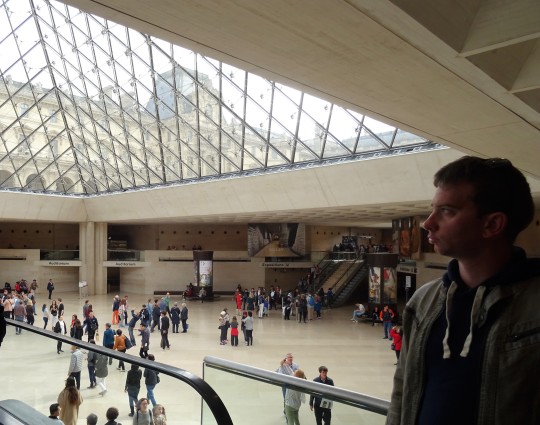
The Foyer under the Glass Pyramid. Leading to all wings
First impressions were great. As we entered the basement of the Sully Wing, we were drawn to the start of the Pavillon de d'Horloge devoted to the history of the museum and its collections including the original fortress of which plenty still remains today.

Relationship of the original fortress within the Louvre
The path led around the base of what remained of the fortress and included a walkway so that we could walk within the original moat.
Prior to his departure on crusade in 1190, Philip II (King Philippe Auguste), son of Louis VII, erected a fortified enclosure to protect Paris against the threat of invaders while he was away. Ordering the construction of a great wall around the city, he reinforced it at the junction with the Seine by building a defensive fortress. Square in plan with corner towers and an imposing central keep. The Seine fed a moat that encompassed the entire structure with another moat surrounding the keep. Two gates, flanked by towers, were built within the wall, one facing south towards the Seine and the other facing east, leading to the city. As Paris spread west, the castle lost its defensive effectiveness and was later transformed into a luxurious royal residence by King Charles V.
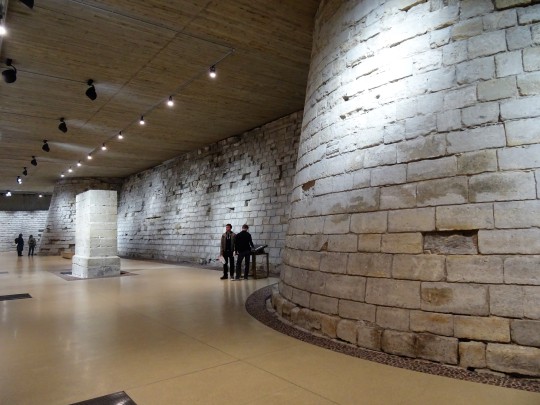
The outer wall of the fortress (and probably the outer moat)

The inner moat and the keep
The path skirted the outer moat and to the far side of the ruins, past the Crypt of the Sphinx and to a long staircase that climbed to the floor above. Halfway up we had a choice, left or right. We chose the right and ended up in the Greek, Etruscan and Roman Antiquities Rooms, which were shared by the Sully and Denon Wings and were welcomed by Athena, a three metre high antique replica of the original bronze from around 430BC.

Great Sphinx of Tanis. "Found" a couple of hundred years ago in the ruins of the Temple of Amun at Tanis (the capital of Egypt during the 21st and 22nd dynasties

Hello! (La Pallas de Velletri)
With Athena behind us, we entered a large room which was full of artefacts from the Greek, or Roman copies of long lost Greek bronzes going back several hundred centuries BC. Bigger than life (they're gods so they should be) statues of Ares, Aphrodites, Zeus, Hermes and such were scattered throughout with smaller, mantle size pieces around the peripheral and reliefs and friezes on the walls.

Aphrodite ("Venus Genitrix")

Zeus, dieu des cieux et maître de l’Olympe
The entire display covered the whole Mediterranean basin from the sixth century AD back to Neolithic times. At the end of the Greek section Venus de Milo, demanding her own room ferried us through to the Etruscan and Roman sections.
Doing an about face, we retraced our steps to the central stairs, descended to the landing, back up to the Egyptian Antiquities section and further to the Near Eastern area in the Richelieu Wing, dominated by Iran and Mesopotamia.
Small alcoves were lined with small figurines of Egyptian history. The larger areas were divided by displays of the same, thereby creating more small alcoves. Almost all of the displays were protected in glass. Interesting stuff, jewellery, trinkets, decorative objects, toys and what seemed like kitchen accessories.

Statue du dieu Horus, worshipped from at least the late prehistoric Egypt until the Ptolemaic Kingdom and Roman Egypt, he was one of the most significant ancient Egyptian deities

Partial sarcophagus lid
The row of sphinxes nearby was interesting, a half a dozen were impressive enough, but apparently several hundred of them lined the processional way to the Serapeum in Saqqara, which has long since gone. An 1850's tomb raider noticed these at various antique shops around town and put two and two together. It was apparent that some of the sphinxes came from the same place so he went out and found the place, thereby finding all of the sphinxes, buried in sand.
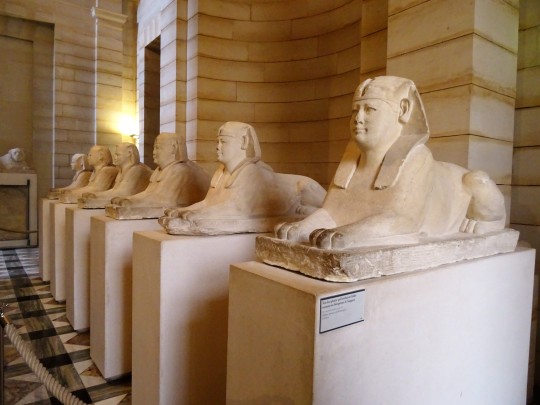
Six des sphinx qui bordaient l'allée menant au Sérapéum de Saqqara
We then came across the mummy sarcophagi, quite a few mainly protected by glass cabinets. Amongst them all was an actual mummy, a well preserved specimen of a male that lived during the Ptolemaic Period. After death and during the mummification process, he was covered in strips of linen and after receiving more attention to dry him out a bit, was covered in cartonnage which consisted of a mask covering his head, a wide collar over his chest, an apron across his legs and a casing over the feet.
This was one of the highlights of the day, probably for everyone as it was difficult to get close to him.

Momie recouverte de ses "cartonnages". Mummy covered with its "Cartonnages ". Embalming jars as well
As the Egyptian section finished, the Near Eastern Antiquities started. The Levant was an area located at the western extreme of the Mediterranean but not too far inland. It seemed to encompass modern day Syria, Jordan, down to what is now the Suez Canal and all between. The sarcophagus of Eshmunazar II, King of Sidon was carved around 500BC for a king whose demise was ahead of his time (he died when 14 years old and ruled the kingdom with his mother). Sidon was located in Phoenicia, now Lebanon and later expanded its horizons by being given lands by the Persian "Lord of Kings", Xerxes as reward by providing their naval fleet to the Persian forces.
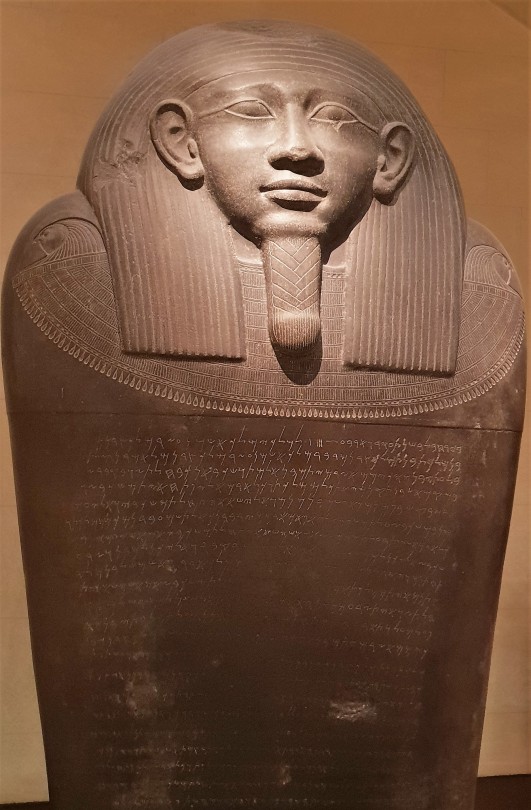
The epitaph across the chest and around the head describes a king who died young and curses on anyone who should trouble his rest among the Rephaïm, followed by a genealogy of the royal family, concluding with a final curse on those who would "raise my slab" and remove the sarcophagus.
The next section was Iran followed by Mesopotamia. There was some great stuff here, the highlights being some friezes from the Persian King Darius I back around 500BC. The first was of lions made of a glazed brick and came from Mesopotamia. They were displayed in his Susa palace and was a symbol of power, embodying the king of beasts. The next frieze was not so certain as to its origins. They were the Archers on Parade depicting two symmetrical lines of soldiers, bow and quiver around their shoulders, both hands holding their spears. Very impressive and quite colourful.
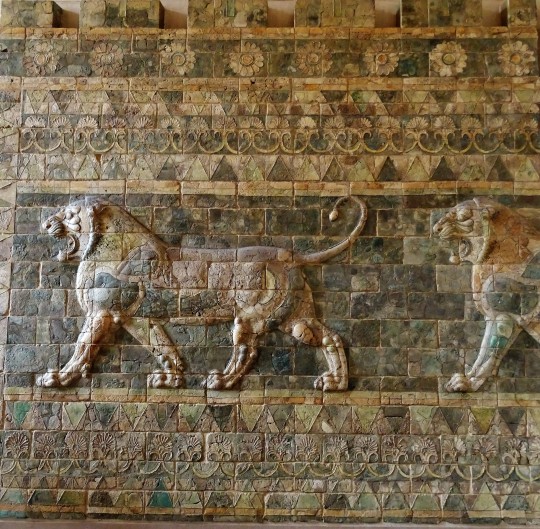
The Frieze of Lions from the first court of Darius I’s palace at Susa

Archers on Parade
Although there was other great stuff in this area, the other impressive artefact was the temple headstock and column (or the colossal capital), one of thirty six that once held up the roof components of the apadana at Susa. A couple of bulls kneeling back to back atop of Egyptian style palm fronds and double volutes with rosettes taken from the temple of Artemis at Ephesus. There wasn't too much in one piece when excavators excavated during the late nineteenth century which explained the colour difference (veined grey limestone brought to the plain of Susa from the Zagros Mountains) due to the capital being reconstructed from bits and pieces of the thirty six columns that originally existed.
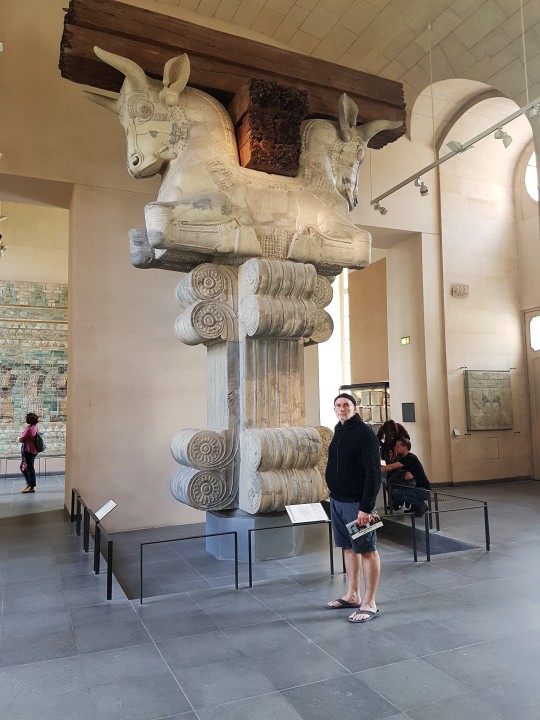
Chapiteau d'une colonne de la salle d'audiences (Apadana) du Palais de Darius Ier
The final part, after a break at the café overlooking Napoléon Hall, was back to the Denon Wing to finish off with a few more statues and some paintings, particularly looking forward to the pushing and shoving in front of the Mona Lisa. After ascending a rather grand staircase we found ourselves on the ground floor amongst the European sculptures before climbing one more floor to the paintings of France, Italy and Spain. One of the final acts of the morning, after wandering through the corridors of religious art was to enter Room 711 where the incredibly underwhelming Mona Lisa proudly hung.
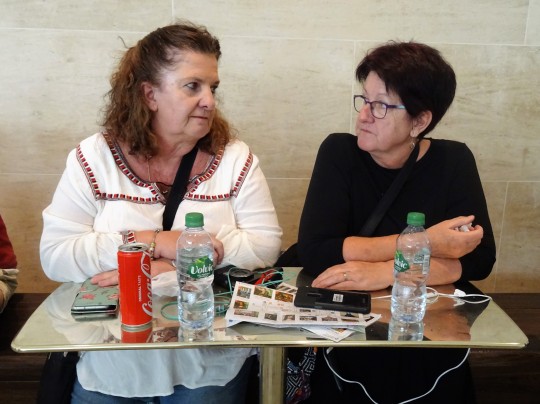
First break for the day.

Andrea di Bartolo dit Solario. La Crucifixion

There she is
That was it. Louvre over and lunch ahead, followed by the tower. Playing it safe, we headed back to where we knew, via the Carrousel du Louvre underground shopping centre, eventually reaching the surface at Arc de Triompe du Carrousel, watched a weirdo pigeon man walking around dropping wheat out of his pockets and braved the irksome Africans and gypsies trying to con us or flog us something. Once through the cordon of conmen we settled in at the Le Carrousel Bar and Brasserie for pizza and snails.

Cordon of conmen
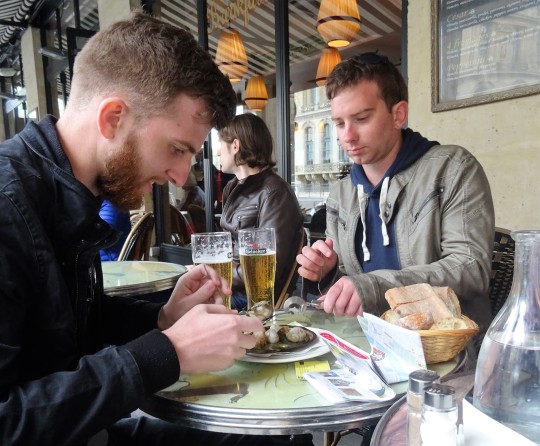
Snails for lunch
After lunch we walked back through the gardens towards Place de la Concorde and further to Avenue Winston Churchill, across the road from the Grand Palais. From there we had a good look at our next destination, the Eiffel Tower. Shane and Jo had seen it before so were doing something different while Cec and the boys went to the top. We proceeded as one to the ticket place where they would meet up with their escort for the trip to the top, then separate for a while.

We Shall Never Surrender
Winston Churchill
Londres le 4 Juin 1940
Leaving Cec, Tom and Beau at the meeting place and agreeing to meet below at the tower ticket collection box later on, Jo and Shane headed along Rue de Grenelle a few streets away to Rue Cler for a Rick Steves audio tour starting with Café Rousillon.
Emmanuel Macron lived in an apartment in Rue Cler before becoming president. Even though he and his wife occasionally shopped in the street, business owners and residents were glad to see the back of them after he was voted in as president. From the vote until the inauguration, the lived in Rue Cler but then moved to Palais de l'élysée, the Presidential residence. During that period the extra security, movement restrictions and extra crowds caused the locals some angst until he left and calm was restored. Shop owners lost business due to street closures. It's okay now and they'll probably be welcomed back when he leaves politics.
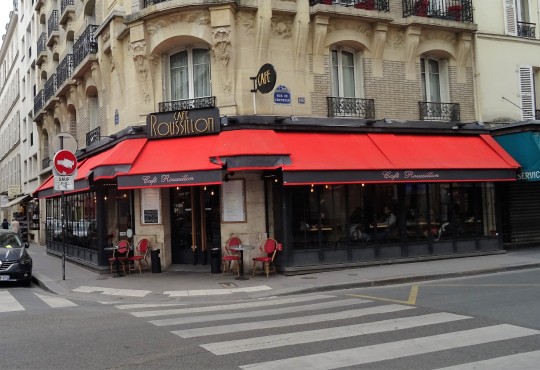
Café Rousillon

At the Bar Prices
Taking Rick's advice and saving money by standing for cafés, we then moved across Rue de Grenelle to a neat and village like street, lined with open aired produce stands, made particularly inviting by excluding all but service vehicles beyond the intersection.
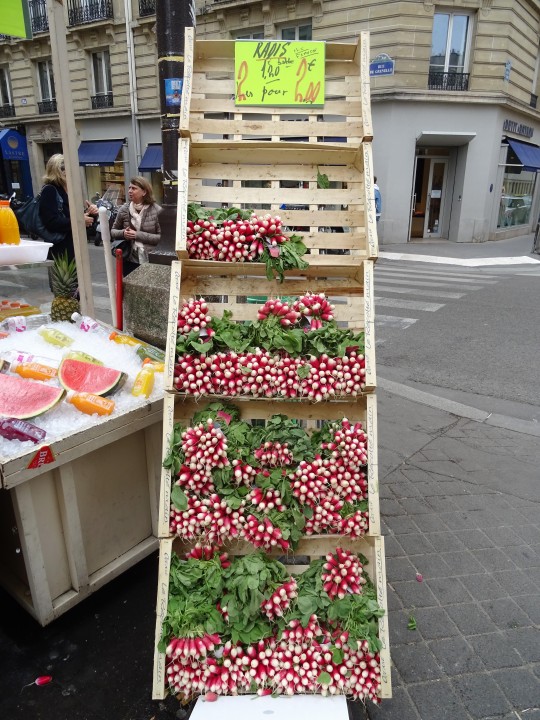
Bunches of radishes. The French have a real flair for produce display
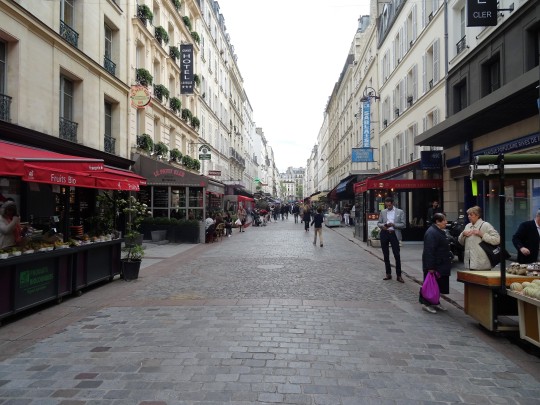
Looking down Rue Cler from Café Rousillion
The street had everything. Apparently, many Parisiennes shop for food daily in street markets just like this as not only are they after fresh food, but their apartments are small and so are their fridges. To shop daily may not only be a preference but a necessity.
Immediately on our left was the only supermarket to be seen, albeit typically small. A fruit stall on either side constricted the street but it soon opened up to specialty shops, hotels and banks, hidden behind closed doors and partially obscured by the fishmongers, cheese shops, bakers and butchers who opened their doors wide and spilled their produce onto the street.
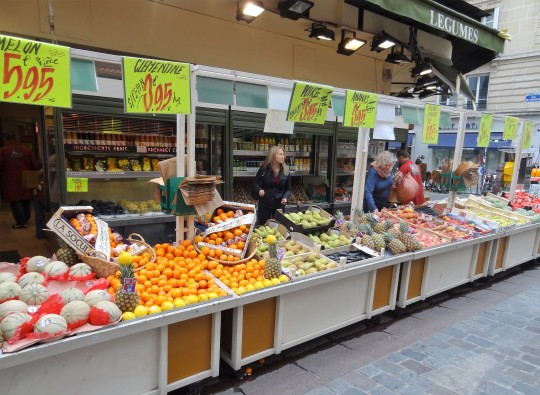
Top Halles
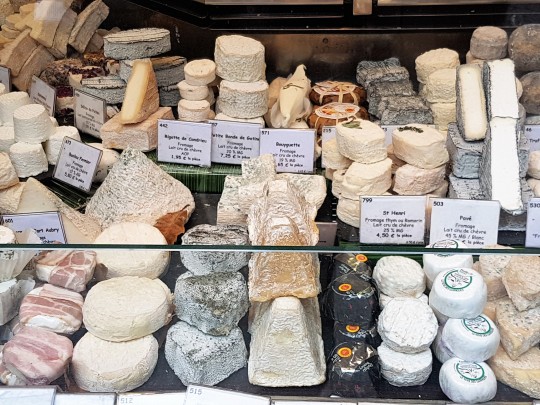
La Fromagerie
La Fromagerie has been in Rue Cler for generations, straight across the street was La Sablaise Poissonniere-Traiteur, supplying fresh seafood daily from the English Channel. There were more cafés, where if one desired could have a café and smoke while sitting on the footpath, facing the crowds, Traiteur Jeusselin which served precooked meal portions for people to buy on their way home from work if too busy to cook and Boucherie du Perche. People around the area didn't have a garden per se, but flower boxes hanging from the window sill. They still had an appetite for flowers as the florist was pretty popular.
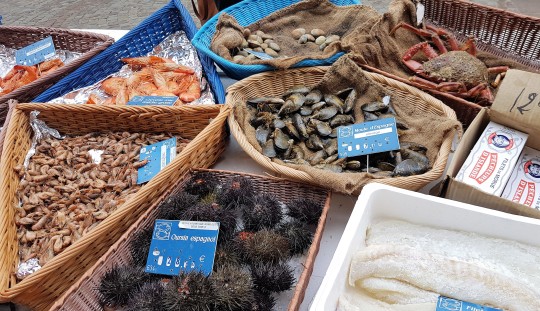
La Sablaise Poissonniere-Traiteur
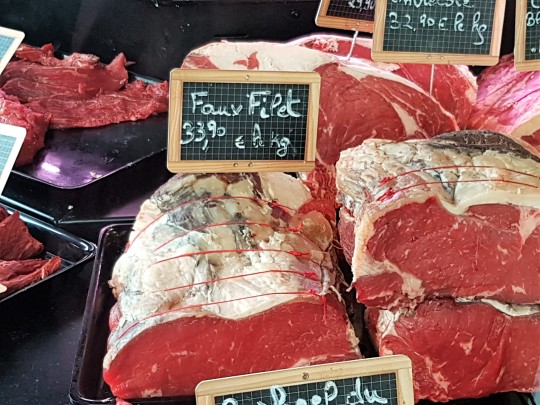
Boucherie du Perche
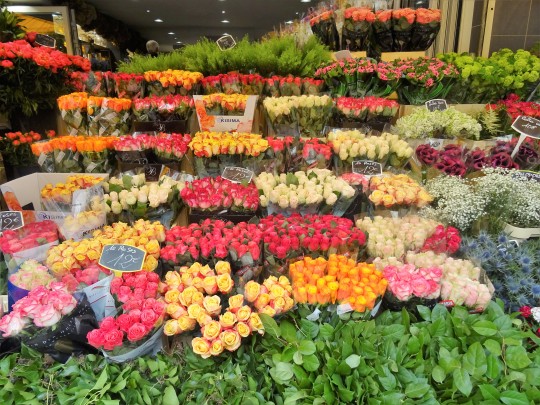
Cler Fleurs
This was an interesting experience but catering more for the top end of town given some of the prices.
Rue Cler came to an abrupt halt at its intersection with Avenue de la Motte-Piquet. Turning right we followed the avenue to the Cavalerie building on Place Joffre, standing at the top of Champ de Mars, a tree lined and grassed park which would lead us to the Eiffel Tower at the other end.
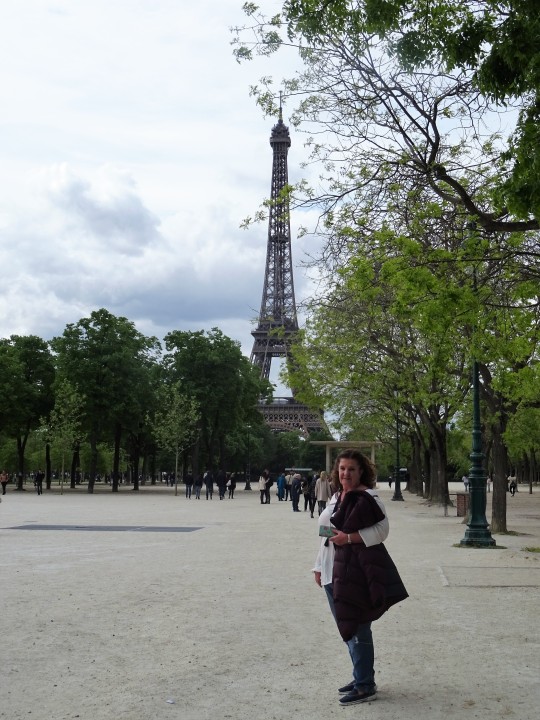
The tower at the end of Champ de Mars
Partially down the Champ de Mars we were lucky enough to experience something that made our day. Amongst the families and couples taking it easy around the place, there was a young couple quickly becoming the centre of attention. The young bloke had a couple of mates with him and duly went down on one knee and opened up a jewellery box with a ring in it. Whilst this was happening one of his mates was playing the violin and the other recording everything. We were a bit far away to hear but she must have said yes as those closer started to applaud. A touching moment to soon be over shadowed by the crowds ahead and the hordes of Africans trying to flog models of the tower.

Romance in Champ de Mars
While this was all happening, Cec, Beau and Thomas were enjoying the city from the top of the tower.
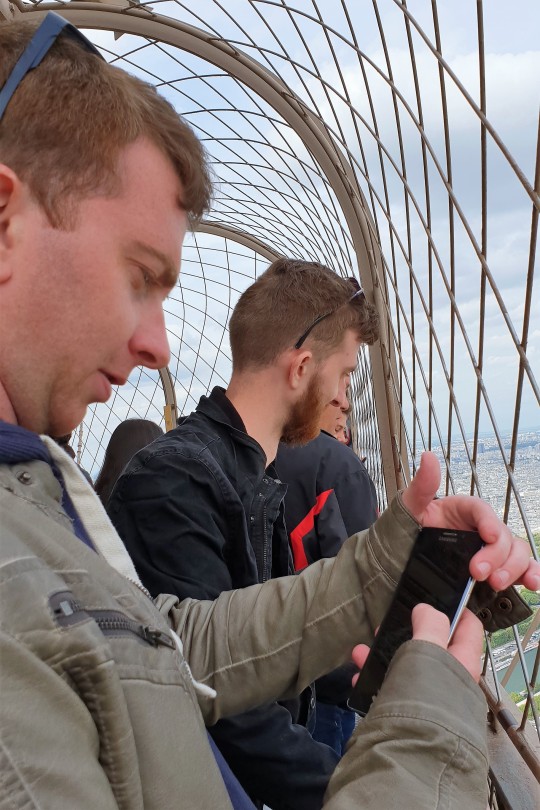
Looking over Paris
As Jo and Shane moved closer to the proposed meeting point below the tower, it was apparent that it would not go to plan. Considerable construction works were underway to construct a "terrorist proof" fence around the tower. The fence will be made of thick glass that will supposedly stop bullets and car bombers and cost several tens of millions of Euro.
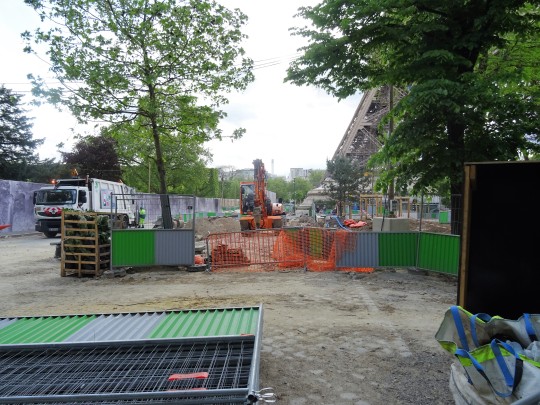
Let the fence begin
With no communication and our meeting plan in tatter as there was no ticket box to meet as planned and there were 4 different entry/exit points, we had no idea where the crew would emerge from. Jo and Shane headed to the park besides the north rafter and waited. Jo wandered around panicking, Shane just sat, moving around, trying to find a seat without bird shit on it. There were plenty of vacant benches for a reason. Just as annoying were the Africans, they were everywhere trying to make a buck. There didn't seem to be much competition as they were all standing together in small groups selling the same thing, models of the tower. They did however, move pretty quickly when the gendarmes approached. Within not to long spent waiting, firstly Tom and Beau walked out the gate followed a short time later by Cecilia, bitchin about how the group dropping them off somehow and they had to fend for themselves. Anyway, it didn't matter now as we were all together again. When asked how did they enjoy their experience, Cecilia said she was too terrified, fearing that an attack on the tower was imminent, As like all major tourist spots, the area had armed troops patrolling the area and being a large city, sirens wailing through the streets was commonplace, we were use to this from previous travels but this was a new experience for Cecilia , thus fuelling her fear for expecting a disaster was pending. Beau has an extreme fear of hieghts but was proud of the fact he did manage to stand at the railings of the top level viewing deck, take in the vista, albeit feeling like he left his fingerprints embedded in the steel hand rail.
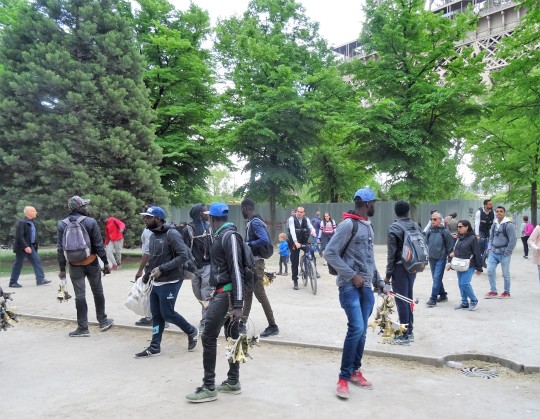
Gendarmes causing a stir
The trip back to the apartment was interrupted by a beer at Café Roussillon in the Le Cler district. While here, Beau made a very interesting observation, on visiting the toilet area of the bar. There was only one toilet that had a step up to it, the disabled toilet. What the Heck!! Time to head home. Women taxied; men walked. By then it was after seven, back at the apartment by eight.
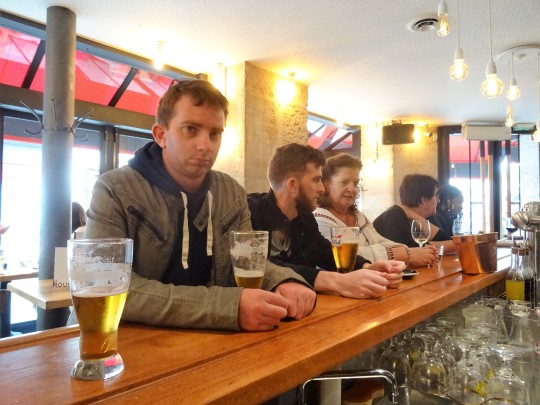
Back at Café Roussillon

Cosy lift

Twilight view from our apartment
Tomorrow, the Catacombes, for the boys, a special treat, for the girls with breakfast and Café Angilina, and then Notre Dame, Saint-Chappelle and the football.
1 note
·
View note
Text
Best 10 Places to Visit
Istanbul
Nearly all Turkey itineraries begin in Istanbul. It’s this city that straddles two continents at once. The Bosphorus Strait acts like a continental border, splitting the city into two halves Napa wineries European and Asian. This city is the center of the country’s film and television industry, which is why many telenovelas, including Kuzey Guney, are not only shot but also set here. When here, make sure you visit the Ottoman Topkapi Palace, the beautiful Hagia Sophia with its intricate mosaics, and the underground Basilica Cistern. Shop until you drop at the Grand Bazaar, take a cruise down the Bosphorus, say a prayer at the Blue Mosque and soak in the cityscape from the Galata tower.
Ankara
Turkey’s capital and second-largest city, Ankara, is a quieter version of Istanbul. Buğra Gülsoy, who plays Guney in Kuzey Guney, was born here. He is among many celebrities who call this city home.The city has all the fine-tuning that come with being a diplomatic seat of power; however, it never bores its visitors. Here, you can visit the Anıtkabir, which is the mausoleum of Mustafa Kemal Ataturk, the founder of Turkey. It is no wonder why this structure dominates the city’s skyline. For panoramic views of the city, head to the Ankara Citadel located in the Ulus Bentderesi District of the Old Quarter. While you are here, go for a walk on the cobblestone alleys of the quarter and take in the quaint Ottoman houses. At the other end of the spectrum is Kizilay Square, filled with buzzing cafes and restaurants.
Bodrum
The star of the Turkish Riviera, Bodrum, is a world-famous getaway for beach lovers. The city sits by the Aegean Sea and offers a fun Mediterranean vibe to visitors. Its enviable location makes many tourists throng the numerous cafes, restaurants, and luxury hotels that line its azure coastline every summer. Kıvanç Tatlıtuğ, who plays the role of Kuzey in Turkey’s most popular show, holidays here often! You could visit Bodrum Castle, the Museum of Underwater Archaeology, the ancient Bodrum Theatre, and Myndos Gate or simply recline on the beach and hope to run into him!
Kas, Antalya
Kas is a quiet seaside town set away from the bustling crowds. It is located in the Antalya region on the Mediterranean coastline of Turkey. If you prefer an itinerary that’s void of a to-do list, this should be your to-go place! This is the best spot to explore the underwater world first-hand with several diving schools that will first train and then take you on guided deep-sea diving tours. You may take a break from that at one of the seaside cafes or explore the colorful streets of the old market! Kas also offers a dose of history in the form of ancient sites like Antiphellos Theatre.
Trabzon
Trabzon offers two-in-one fun: it’s located by the Black Sea in north-eastern Turkey and has the Pontic Mountains pass through it; this creates a hill station-like ambiance. The region offers a different take on Turkey, one that’s sprinkled with bouts of silence. Explore the Sumela Monastery, a Greek Orthodox Ministry built in the year 346 AD. Spend a night near the Uzun Göl or Long Lake, enjoy a sunset over the Black Sea at Boztepe, and pay respects to the nation’s founding father at the Trabzon Ataturk Kosku museum. Trabzon also has its own Hagia Sophia that’s a little different from the one in Istanbul!
Cappadocia
You will know you’re in Cappadocia when you look up and see colorful hot air balloons floating in the sky. Of course, the best view from one of these balloons is that of the UNESCO World Heritage Site-listed Goreme Open Air Museum, which is home to rock-cut churches that once sheltered Byzantine monks. Equally fascinating are the region’s 36 underground cities—; the most prominent one being the Kaymakli Underground City. Once you’re done touring the sights in Istanbul and Ankara, there are direct flights that connect you to this city in the central Anatolian region of Turkey. You can visit the various pottery shops, the Pasabag, and Devrent Valley, and even check into a cave hotel!
Ephesus
If you are a lover of history then Ephesus must make an entry in your Turkey travel map. It is located about one hour away from Izmir, a city in which many of Turkey’s most popular shows have been set. Ephesus was once an ancient Greek city and today its ruins are very interesting to visit. The entire area is now a UNESCO World Heritage Site, and its must-visit places include the remains of the Temple of Artemis, the Temple of Hadrian, the Basilica of St. John and the Ephesus Museum where you will be captivated by the Artemis statute and the Gladiator Room. The Isa Bey Mosque is an important religious center as is the Meryemana.
Konya
Konya is a romantic city—the kind that would lure dreamers and poets. It’s no wonder why the famous Sufi poet and whirling dervish, Mevlana Rumi, penned his famous, heart-touching verses here in the 13th century. Without a doubt, your first stop should be at the Mevlana Museum that’s adorned with gorgeous roses and contains the tomb of the renowned poet. Its Semahane contains a museum exhibiting religious items from the era. Head to the Alaeddin Tepe park for an evening stroll and cup of Turkish tea. The other fine arts in Konya are represented by the Tile Museum and Museum of Wooden and Stone Carving, ensuring that all lovers of art have a gala time here!
Pamukkale
Pamukkale literally translates to “cotton castle.” One look at its whitewashed terrain and you will know why! The natural site in southwestern Turkey abounds with hot springs rich in the mineral travertine and has been drawing visitors since the 2ndcentury B.C.! Declared a UNESCO World Heritage Site, Pamukkale combines mineral forests, waterfalls, and terraced basins into an open-air spa in a surreal landscape. Take a dip in the calcium-rich travertines, trek up Pamukkale Castle, and learn about Cicero in the Roman ruins of Laodikeia. You may also explore the Hierapolis City Ruins that, along with the springs, make up this UNESCO site.
Bursa
Bursa is so verdant that it was nicknamed "Yeşil Bursa" (Green Bursa) because of the number of parks and gorgeous mountain within and around it. It once served as the capital of the Ottoman state, and its importance as an industrial center continues to this day. In the winters, it is a major attraction for skiers because of the ski resort of Mount Uludağ that overlooks it. In the summers, the mountain provides respite from the heat and wonderful mountain vistas. Take the teleferik to go up to the top. Cumalıkızık, with its quaint cobblestone streets, is a preserved Ottoman village just outside the city center that offers a peek into the traditional Turkish way of life, head here for its huge village breakfast spreads. Buy souvenirs like ebru painting, lithography, ceramics and tiles, calligraphy, metal art, and Ottoman-period antiques at the Kayhan Bazaar. Also, don’t miss the natural thermal spas and hammams!
1 note
·
View note
Photo
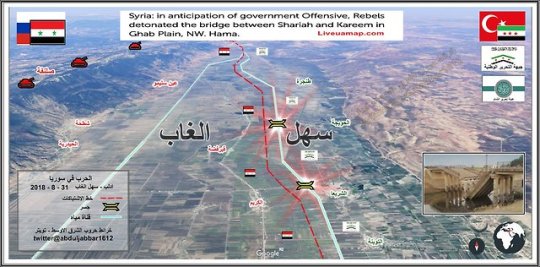
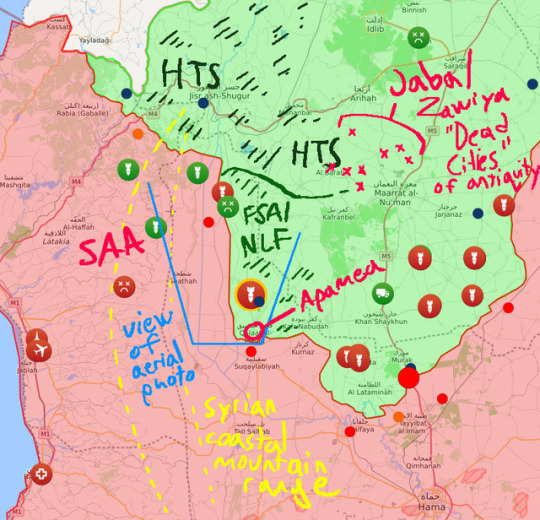
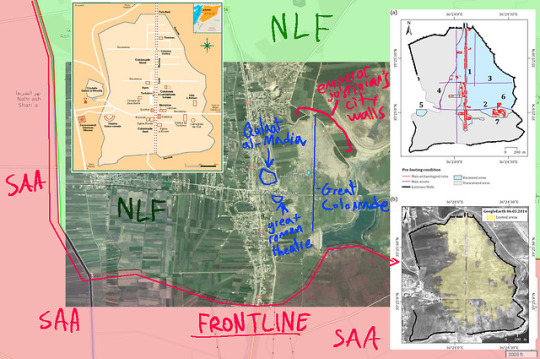
Analysis of the southwestern Idlib frontline, including recent bridges blown out by rebels on the Ghab plain and heritage landmarks, east of the mountain range that is held by the SAA
In the lower right of the first info graphic should be a turkish observation post.
The rebels here are all NLF/Turkish backed FSA
This is potentially the weakest yet the most culturally sensitive front line of the rebels in Idlib on account of the Syrian artillery facing them, to the west, on the ridge of the Syrian coastal mountain range/Jabal An-Nusariyah. Fun fact: this mountain range is home to Masyaf and was the domain of the late Order of Assassins (Nizari Hashshashin), of ass ass creed fame and the origin of the term “assassin” itself.
This position is greatly untenable, so rebels have blown out the agricultural canal bridges crossing into their territory and have begun to dig in. To this point, it is a culturally sensitive defensive position because the literal frontline lays before the rebel occupied Seleucid/Roman metropolis of Apameia, historically renown for being part of the Syrian Tetrapolis, the cities of Antioch, Seleucia Pieria, Apamea, and Laodicea (contemporary Latakia) that were regarded as the greatest ones founded by Alexander the Great’s general, Seleucus Nicator. The ruined site lays beside, and dwarfs the city and medieval citadel of Qalaat al-Madiq, which was once purchased and occupied by the order of Assassins.
As it stands, Apamea is home to two significant ancient features of remark:
The roman theatre that, along with the Roman Theatre in Ephesus, is the largest surviving theatres of it’s kind. It remains largely unexcavated:

And of greater note, the Great colonnade, the largest surviving colonnade structure in the Roman empire, stretching across the entire city site, which also lay mostly unexcavated.
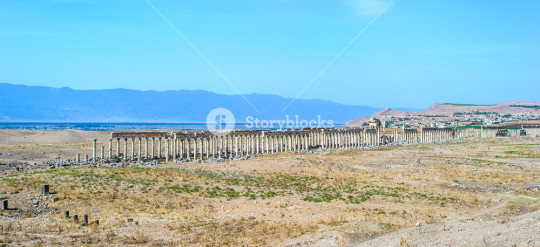
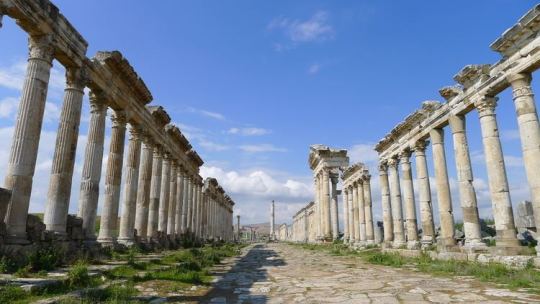
And i point out the unexcavated nature of the site because, unlike ISIS occupied sites, which got worldwide coverage for how ISIS looted and destroyed ancient landmarks, here in apameia and in other places like it, the site has been widely looted and ravaged under western-backed rebel watch:
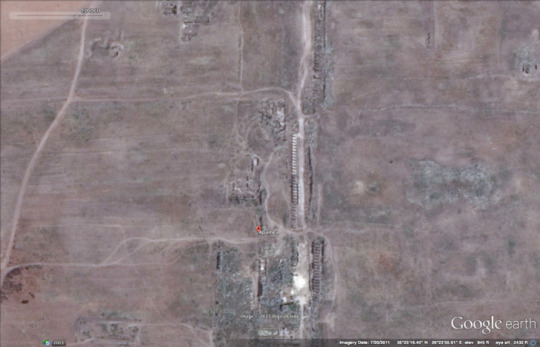

So already, there is extensive damage to the site and this stands to show how much the rebels value the integrity of the ruins if and when the Syrian Arab Army arrives.
You can view the site here:
https://goo.gl/maps/fwLqmtpCVhz
Ground conflict isn’t really anticipated quite yet as the SAA will be expected to focus the brunt of it’s offense against HTS far to the northwest. However, war will come to Qalaat al-Madiq and beyond, to deeper into Idlib, where even more culturally sensitive areas reside. Namely, the “dead cities” as the medieval Syrians and islamic cartographers came to call the vast array of ruined cities and desolate villages (over 700 in total) that once formed this highly urbanized, commercially affluent highlands during the height of the Roman empire. This region quickly became desolate following the Arab conquests and transformation of the region into a contested space between the Byzantines and Muslim successors, made permanently economically depressed after the interruption of the Roman trade routes that were integral to the immense wealth of agricultural/trade networks in the area.
The state of these dead cities provides a glimpse into the transition from pagan to christian/byzantine rome. They are scattered in clusters from southern idlib, North to Afrin and across to Aleppo. The closest cluster to Apamea is the one in Jabal Zawiya, which i marked with several of the most significant sites there including Serjilla, of which i attached two photos.

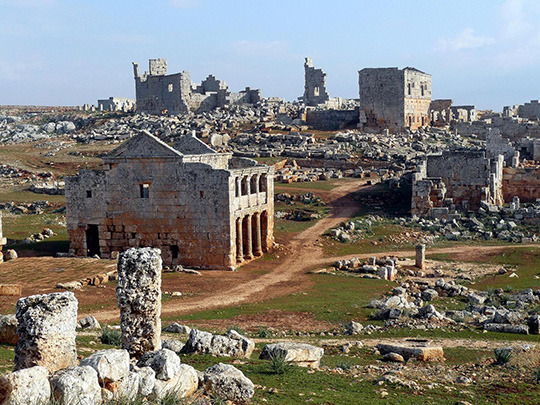
Much of these sites are not as endangered as grand sites like Apamea, due to their relatively remote locations.
#qalaat al-madiq#apamea#apameia#seleucus#seleucid#roman empire#dead cities#byzantine#byzantium#byzantine empire#antiquity#idlib#syria#syrian arab army#NLF#National Front for Liberation#fsa#Free syrian army#SAA#Syrian civil war
25 notes
·
View notes